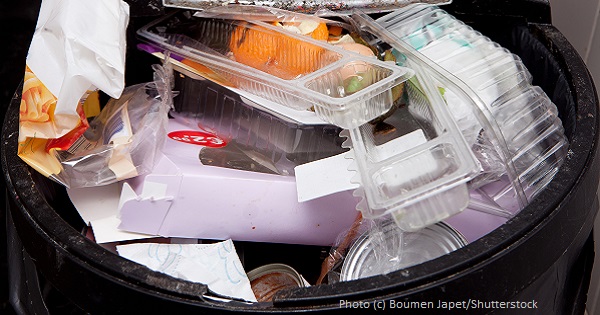|

How to Reduce Kitchen Waste
by Wendy Priesnitz
Do you want to reduce the waste your household produces? Well, the kitchen is a great place to begin. And, in the process, both your family and the planet will be healthier as you minimize exposure to tin cans and plastic, and you will save money.
The Problem
If you think of the waste generated in your home, you will realize that most of it is either compostable food waste or packaging, much of that made of plastic in one form or another.
The International Plastics Task Force, a global network of activists, ecologists, non-profit organizations and waste management experts, says that “plastic has become an environmental problem of global scale.” Plastics are essentially a byproduct of petroleum refining – and, of course, petroleum is a non-renewable and rapidly declining resource. Various chemicals such as plasticizers, antioxidants, anti-static agents, colorants, flame retardants, heat stabilizers and barrier resins are added to give plastic products their performance properties. The emissions from chemical plants that make the plastics and their additives have been ranked at or near the top of the list of carcinogens by the U.S. Environmental Protection Agency (EPA).
People are exposed to these chemicals not only from the manufacturing process, but also by using products made from plastic, by eating food contained in plastic packaging and even by breathing them as they off-gas in the indoor environment.
Plastics are very stable and therefore stay in the environment a long time after they are discarded, especially if they are shielded from direct sunlight by being buried in landfills. Decomposition rates are further decreased in food containers by the antioxidants that are often added to enhance their resistance to attack by acidic contents.
At the same time, the low cost of plastics has enabled the development of disposable products, which has increased the amount of trash. Plastics account for an estimated one-quarter of all waste in landfills. Tens of billions of pounds of plastic are used for packaging designed to be discarded as soon as the package is opened.
Some types of plastic are accepted in municipal recycling programs, although a significant amount never makes it there. (See this article for more details about recycling plastic.) But, as the International Plastics Task Force points out, plastics don’t actually recycle. Instead of being reformed back into the original products, they are reprocessed into secondary (and usually non-recyclable) products.
My bottom line is that if I prevent plastic from entering my kitchen, I don’t have to worry about how to deal with it.
How to Minimize Kitchen Waste
-
Store foods, especially those with high fat content, in something other than plastic, preferably glass jars or Pyrex-like containers.
-
Avoid microwaving foods in plastic (if you microwave at all) and cover them with a cloth towel.
-
Buy cheese and meat from a dairy and butcher and ask them not to wrap it in plastic.
-
For produce, cotton mesh bags are available for purchase, or you can make your own drawstring bags.
-
Avoid plastic bags at stores by taking reusable cloth bags.
-
Buy foods like peanut butter, as well as laundry soap, shampoo and other products in bulk, using your own containers. If you have storage space, this minimizes waste packaging and saves money.
-
Avoid take-out food, or alert the restaurant when you order that you’ll bring your own containers.
-
Cook from scratch, which can be healthier, save time if you freeze unused quantities, and minimize packaging.
-
Make your own yogurt at home in a thermos or yogurt maker, and store in glass jars.
-
Buy eggs in paper cartons and return them for reuse or recycling.
-
At coffee shops, take your own mug or, if you’re not having it “to go,” ask for a china mug.
-
Wash and reuse any plastic containers you feel you must buy.
-
Replace paper with cloth dishcloths and napkins; use containers with lids instead of aluminum foil and plastic wrap; avoid disposable plates and cups.
-
Use a compost collector in your kitchen that doesn't require lining; stainless steel works well.
Wendy Priesnitz is the editor of Natural Life Magazine. She has been an environmentalist and journalist for over 40 years, and is the author of thirteen books, including Natural Life Magazine's Green and Healthy Homes.
|

